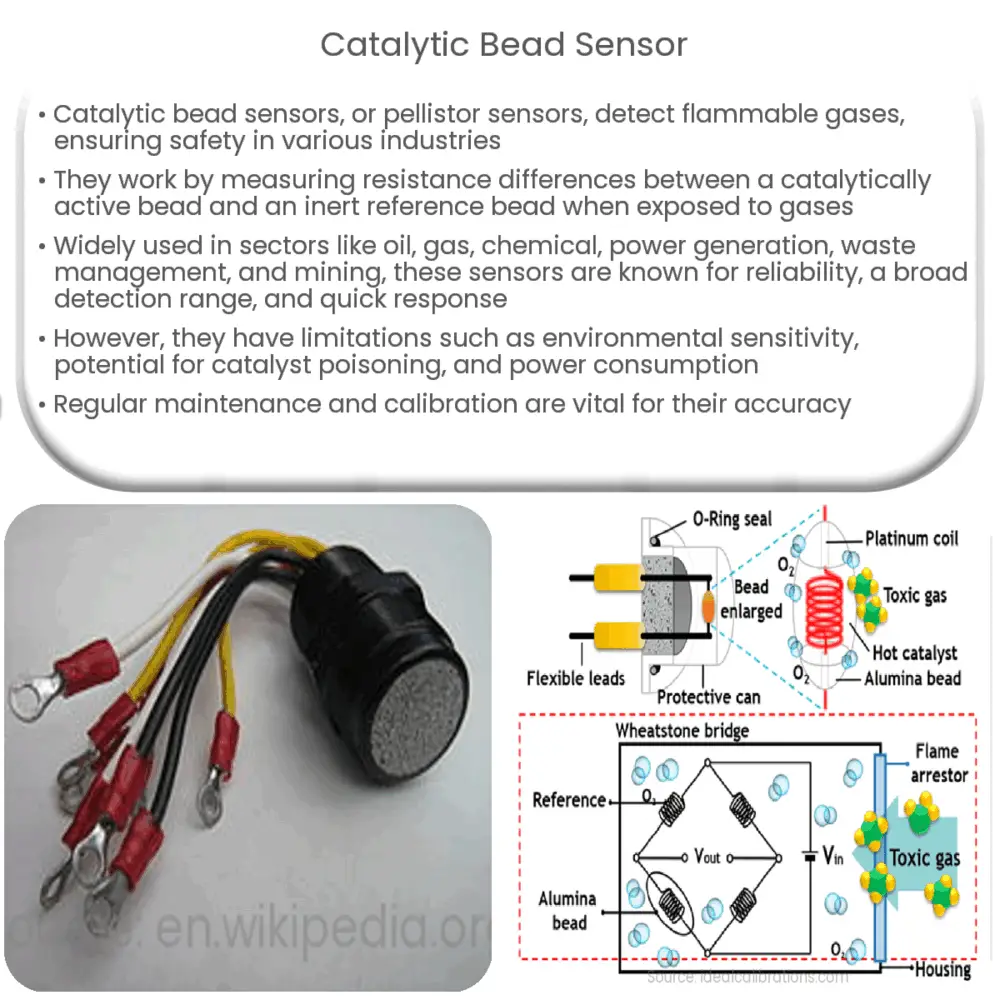Catalytic bead sensors detect flammable gases, ensuring safety in various industries. They offer reliability, a wide detection range, and fast response time, with some limitations.

Catalytic Bead Sensors: An Overview
Introduction
Catalytic bead sensors, also known as pellistor sensors, are widely used in various industries to detect flammable gases and vapors. These sensors play a critical role in ensuring the safety of workers, equipment, and facilities by alerting users to the presence of hazardous concentrations of combustible substances. In this article, we will discuss the working principle of catalytic bead sensors, their applications, advantages, and limitations.
Working Principle
Catalytic bead sensors consist of two elements: a catalytic bead and a reference bead. Both beads are made of a platinum wire coil embedded within a ceramic material. The catalytic bead is coated with a catalyst, typically platinum or palladium, which promotes the oxidation of flammable gases. The reference bead, on the other hand, is inert and does not participate in any chemical reactions.
When a flammable gas comes into contact with the catalytic bead, the catalyst promotes an oxidation reaction, which generates heat. This heat increases the temperature of the catalytic bead, causing the electrical resistance of the platinum wire to rise. The reference bead, being inert, remains unaffected by the presence of flammable gases and maintains a constant resistance. The sensor measures the difference in resistance between the two beads, which is directly proportional to the concentration of the flammable gas present in the environment.
Applications
Catalytic bead sensors find applications in a variety of industries where the detection of combustible gases is crucial for safety. Some common applications include:
- Oil and gas industry: Monitoring for gas leaks in pipelines, refineries, and storage facilities to prevent fires and explosions.
- Chemical industry: Detection of flammable vapors in chemical plants and storage areas.
- Power generation: Monitoring for the presence of combustible gases in coal-fired power plants, gas turbines, and other power generation facilities.
- Waste management: Detection of methane and other flammable gases in landfills and wastewater treatment plants.
- Mining industry: Monitoring for methane and other explosive gases in underground mines to prevent mine accidents.
Advantages
Catalytic bead sensors offer several advantages, which have contributed to their widespread adoption in various industries:
- Reliability: These sensors have been used for decades and have a proven track record of reliable performance in detecting flammable gases.
- Wide detection range: Catalytic bead sensors can detect a wide range of flammable gases and vapors, making them suitable for diverse applications.
- Fast response: The sensors provide a rapid response to changes in gas concentrations, allowing for timely intervention in case of gas leaks or hazardous situations.
Limitations
Despite their advantages, catalytic bead sensors also have certain limitations:
- Sensitivity to environmental factors: These sensors can be affected by changes in temperature, humidity, and pressure, which may lead to false alarms or reduced sensitivity.
- Poisoning and inhibition: The catalyst on the catalytic bead can be poisoned or inhibited by certain chemicals, such as silicones, halogens, and sulfur compounds, resulting in reduced sensitivity or complete sensor failure.
- Limited selectivity: Catalytic bead sensors respond to various flammable gases and cannot differentiate between them, which might be a disadvantage in certain applications where specific gas detection is required.
- Power consumption: These sensors require a continuous power supply to maintain their operation, which can be a disadvantage in remote or battery-powered applications.
Maintenance and Calibration
To ensure the reliable operation of catalytic bead sensors, regular maintenance and calibration are essential. Maintenance involves periodic inspection of the sensor elements for damage or contamination and cleaning or replacing the beads as necessary. Calibration involves exposing the sensor to a known concentration of a target gas and adjusting its output to match the known value. This process helps to maintain the accuracy and reliability of the sensor over time.
Conclusion
Catalytic bead sensors are a proven and reliable technology for detecting flammable gases and vapors in various industries. They offer advantages such as a wide detection range, fast response, and a long history of successful use. However, they also have certain limitations, including sensitivity to environmental factors, susceptibility to poisoning and inhibition, limited selectivity, and power consumption. By understanding these limitations and taking appropriate measures for maintenance and calibration, users can ensure the reliable and safe operation of catalytic bead sensors in their applications.
References
- Lipták, B.G. (2017). Instrument Engineers’ Handbook, Volume One: Process Measurement and Analysis. CRC Press.
- Gardner, J.W. & Bartlett, P.N. (1999). Electronic Noses: Principles and Applications. Oxford University Press.
- Solomon, S. & Gupta, R.C. (2009). Handbook of Environmental Analysis. CRC Press.

